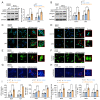Tumor suppressive functions of hsa‑miR‑34a on cell cycle, migration and protective autophagy in bladder cancer
- PMID: 37083075
- PMCID: PMC10147313
- DOI: 10.3892/ijo.2023.5514
Tumor suppressive functions of hsa‑miR‑34a on cell cycle, migration and protective autophagy in bladder cancer
Abstract
Bladder cancer (BC) cells exhibit a high basal level of autophagy activity, which contributes to the development of a protective mechanism for cellular survival against current treatments. Hsa‑microRNA‑34a (miR‑34a) presents anti‑tumor function in several types of cancer. However, the functional mechanism of miR‑34a in regulating tumor aggressiveness and protective autophagy of BC remains largely unknown. First, transfected BC cells with miR‑34a mimic exhibited LC3‑II and p62 accumulation through immunofluorescence staining. It was demonstrated that syntaxin 17 (STX17), which is required for autophagosome‑lysosome fusion, was downregulated upon miR‑34a mimic treatment. Mechanistically, miR‑34a reduced the expression of STX17 proteins that directly bind on STX17 3'‑untranslated regions and thus suppressed STX17 mRNA translation to eventually inhibit protective autophagy in BC. Cell viability and colony formation assays revealed that overexpression of miR‑34a in BC cells enhances the chemosensitivity of cisplatin, doxorubicin, epirubicin and mitomycin C. Furthermore, miR‑34a inhibited cell proliferation and triggered G0/G1 cell cycle arrest by inhibiting cyclin D1 and cyclin E2 protein expression. Moreover, miR‑34a suppressed cell motility through the downregulation of epithelial‑mesenchymal transition. In summary, miR‑34a inhibits cell proliferation, motility and autophagy activity in BC, which can benefit BC treatment.
Keywords: autophagy; bladder cancer; hsa‑microRNA‑34a; motility; syntaxin 17.
Conflict of interest statement
The authors declare that they have no competing interests.
Figures







Similar articles
-
Knockdown of long non-coding RNA metastasis associated lung adenocarcinoma transcript 1 inhibits the proliferation and migration of bladder cancer cells by modulating the microRNA-34a/cyclin D1 axis.Int J Mol Med. 2019 Jan;43(1):547-556. doi: 10.3892/ijmm.2018.3959. Epub 2018 Oct 29. Int J Mol Med. 2019. PMID: 30387807
-
miR‑21 inhibits autophagy and promotes malignant development in the bladder cancer T24 cell line.Int J Oncol. 2020 Apr;56(4):986-998. doi: 10.3892/ijo.2020.4984. Epub 2020 Feb 13. Int J Oncol. 2020. PMID: 32319564
-
MicroRNA‑34a‑5p serves as a tumor suppressor by regulating the cell motility of bladder cancer cells through matrix metalloproteinase‑2 silencing.Oncol Rep. 2021 Mar;45(3):911-920. doi: 10.3892/or.2020.7910. Epub 2020 Dec 24. Oncol Rep. 2021. PMID: 33650650 Free PMC article.
-
Oncogenic role of MIR516A in human bladder cancer was mediated by its attenuating PHLPP2 expression and BECN1-dependent autophagy.Autophagy. 2021 Apr;17(4):840-854. doi: 10.1080/15548627.2020.1733262. Epub 2020 Mar 1. Autophagy. 2021. PMID: 32116109 Free PMC article.
-
Targeted therapy using nanocomposite delivery systems in cancer treatment: highlighting miR34a regulation for clinical applications.Cancer Cell Int. 2023 May 6;23(1):84. doi: 10.1186/s12935-023-02929-3. Cancer Cell Int. 2023. PMID: 37149609 Free PMC article. Review.
Cited by
-
Antitumor Effects of Sesamin via the LincRNA-p21/STAT3 Axis in Human Bladder Cancer: Inhibition of Metastatic Progression and Enhanced Chemosensitivity.Int J Biol Sci. 2025 Mar 31;21(6):2692-2706. doi: 10.7150/ijbs.103274. eCollection 2025. Int J Biol Sci. 2025. PMID: 40303286 Free PMC article.
-
Sea buckthorn flavonoids and their derivatives: potential natural compounds for the treatment of diabetic cardiomyopathy.Front Pharmacol. 2025 Jul 17;16:1599756. doi: 10.3389/fphar.2025.1599756. eCollection 2025. Front Pharmacol. 2025. PMID: 40746722 Free PMC article. Review.
-
Research Progress on Micro (Nano)Plastics Exposure-Induced miRNA-Mediated Biotoxicity.Toxics. 2024 Jun 29;12(7):475. doi: 10.3390/toxics12070475. Toxics. 2024. PMID: 39058127 Free PMC article. Review.
-
The role of miR-16 and miR-34a family in the regulation of cancers: A review.Heliyon. 2025 Feb 17;11(4):e42733. doi: 10.1016/j.heliyon.2025.e42733. eCollection 2025 Feb 28. Heliyon. 2025. PMID: 40061926 Free PMC article. Review.
-
Natural compounds as modulators of miRNAs: a new frontier in bladder cancer treatment.Med Oncol. 2025 Jan 30;42(3):56. doi: 10.1007/s12032-025-02613-8. Med Oncol. 2025. PMID: 39883227 Review.
References
-
- Zhao L, Sun J, Wang K, Tai S, Hua R, Yu Y, Fan Y, Huang J. Development of a new recurrence-free survival prediction nomogram for patients with primary non-muscle-invasive bladder cancer based on preoperative controlling nutritional status score. Cancer Manag Res. 2021;13:6473–6487. doi: 10.2147/CMAR.S323844. - DOI - PMC - PubMed
MeSH terms
Substances
LinkOut - more resources
Full Text Sources
Medical
Research Materials
